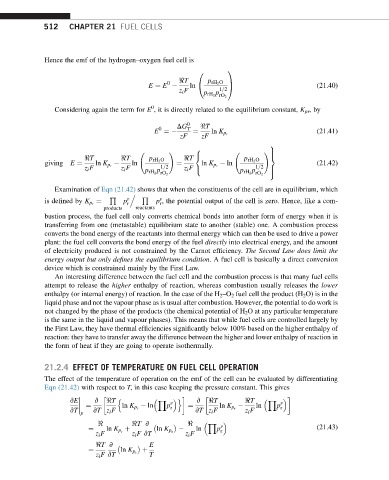Page 519 - Advanced thermodynamics for engineers
P. 519
512 CHAPTER 21 FUEL CELLS
Hence the emf of the hydrogen–oxygen fuel cell is
1
0
<T
0 p rH 2 O C
E ¼ E ln @ A (21.40)
1=2
z i F p rH 2 rO 2
p
0
Considering again the term for E , it is directly related to the equilibrium constant, K pr ,by
DG 0 <T
0 T
E ¼ ¼ ln K p r (21.41)
zF zF
9
8
! !>
<T <T p rH 2 O <T < p rH 2 O =
>
giving E ¼ ln K p r ln ¼ ln K p r ln (21.42)
z i F z i F p 1=2 z i F : p 1=2 >
>
p rH 2 rO 2 p rH 2 rO 2 ;
Examination of Eqn (21.42) shows that when the constituents of the cell are in equilibrium, which
.
Q n Q n
¼ p p , the potential output of the cell is zero. Hence, like a com-
is defined by K p r r r
products reactants
bustion process, the fuel cell only converts chemical bonds into another form of energy when it is
transferring from one (metastable) equilibrium state to another (stable) one. A combustion process
converts the bond energy of the reactants into thermal energy which can then be used to drive a power
plant: the fuel cell converts the bond energy of the fuel directly into electrical energy, and the amount
of electricity produced is not constrained by the Carnot efficiency. The Second Law does limit the
energy output but only defines the equilibrium condition. A fuel cell is basically a direct conversion
device which is constrained mainly by the First Law.
An interesting difference between the fuel cell and the combustion process is that many fuel cells
attempt to release the higher enthalpy of reaction, whereas combustion usually releases the lower
enthalpy (or internal energy) of reaction. In the case of the H 2 –O 2 fuel cell the product (H 2 O) is in the
liquid phase and not the vapour phase as is usual after combustion. However, the potential to do work is
not changed by the phase of the products (the chemical potential of H 2 O at any particular temperature
is the same in the liquid and vapour phases). This means that while fuel cells are controlled largely by
the First Law, they have thermal efficiencies significantly below 100% based on the higher enthalpy of
reaction: they have to transfer away the difference between the higher and lower enthalpy of reaction in
the form of heat if they are going to operate isothermally.
21.2.4 EFFECT OF TEMPERATURE ON FUEL CELL OPERATION
The effect of the temperature of operation on the emf of the cell can be evaluated by differentiating
Eqn (21.42) with respect to T, in this case keeping the pressure constant. This gives
v <T n Y o v <T <T Y
vE n n
¼ ln K p r ln p r ¼ ln K p r ln p r
vT vT z i F vT z i F z i F
p
< <T v < Y
n
¼ ln K p r þ ln K p r ln p r (21.43)
z i F z i F vT z i F
E
<T v
¼ ln K p r þ
z i F vT T

